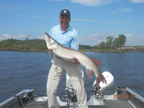|
|
Posts: 433
Location: Cedarburg, Wisconsin | Just was wondering if anybody could explain this to me. I always enjoy learning new things and am hoping somone out there, a lot smarter than I am on the subject, can give some good advice how props are designed and described.
I see some props are said to have good bow lift, some good stern lift, and other various qualities. What causes the lift to mainly the bow vs. the stern? Is it the pitch, the rake, the diameter, the number of blades or something else?
If you are talking about a hole shot, obviously the motor has to be able to rev up in a hurry to be effective, but if there is too much venting it just loses bite completely. To get better bite as I understand it, you can either go with less venting, a larger diameter or more blades from what I've read. What is the advantage of larger diameter verses more blades if they both do the same thing?
You see prop choices with solid through hub exhaust, with vent holes or over and through hub exhaust. Obviously that is to control the amount of venting for better hole shots, but is there an advantage to one method of venting over the others?
| |
| | |

Posts: 3508
Location: Elk River, Minnesota | Hiya,
I'll do my best to answer this to the best of my knowledge.
Starting with your first main question, There are two basic things that will help to increase bow lift: Rake angle and cupping toward the tip of the prop. A good example of this would be to look at a ballistic prop which has a modified tip (like it has been cut off) then cupped. I think the reason why this happens is the tip cupping is forcing water inward to the prop fin enough to allow your trim to be more effective.
If memory serves me correctly, Rake angle helps to lift the entire boat both bow and stern since it encompasses the entire blade fin. Stern lift usually is helped with cupping on the trailing edge of the blade more toward the hub. When the prop is rotating and the fin is traveling downward as it compares to the boat hull, it will essentially push the stern up since the cupping adds a little resistance to the water flowing over it.
In terms of hole shot, you are correct...smaller vent holes and/or more fins/larger fins will help to curtail excess venting. With more fins, you gain surface area (more contact with water) to push the boat forward. The same holds true for a larger diameter prop...more blade surface, more thrust potential. The trade off is loss of top end on either larger diameter or more blades since the extra surface area also means more resistance in the water as well. That is why you see so many pontoon boats with 4 blade props, and in some cases big cruisers with inboard/outboard setups that have upwards of 5 blades to essentially a double-prop design with what looks like two props stacked one after the other.
With regards to venting the prop, they all do the same thing. Most over-hub designs are used on high speed applications where hole shot is still premium. When those are set up well, the boat jumps on plane and is off like a rocket. But...you would NOT want something like this with big boats that will be in any sort of wind where having to slow down is needed for safety reasons. The most cost-effective choice is a hub vented prop that has different sized plugs you can put in to set up the prop to the way you would like it. Pulling skiers, larger holes for that quick hole shot to get them up. Fishing walleyes in chop, smaller holes to be able to run the boat at midrange speeds without losing bite. It is definitely a fine line.
I hope this helps some, and my memory is at least somewhat on the mark about what is going on down there. Lots of physics taking place....
Steve | |
| | |
Posts: 433
Location: Cedarburg, Wisconsin | Thanks for the information VMS! Just the kind of information I was looking for.
That helps to understand props. It can get pretty confusing reading different manufacturer's descriptions of props that all look fairly similar in their little bitty pictures on the net. It's always nice to know the physics behind the actions.
Thanks again! | |
| |
|
 Several prop questions?
Several prop questions? Several prop questions?
Several prop questions?